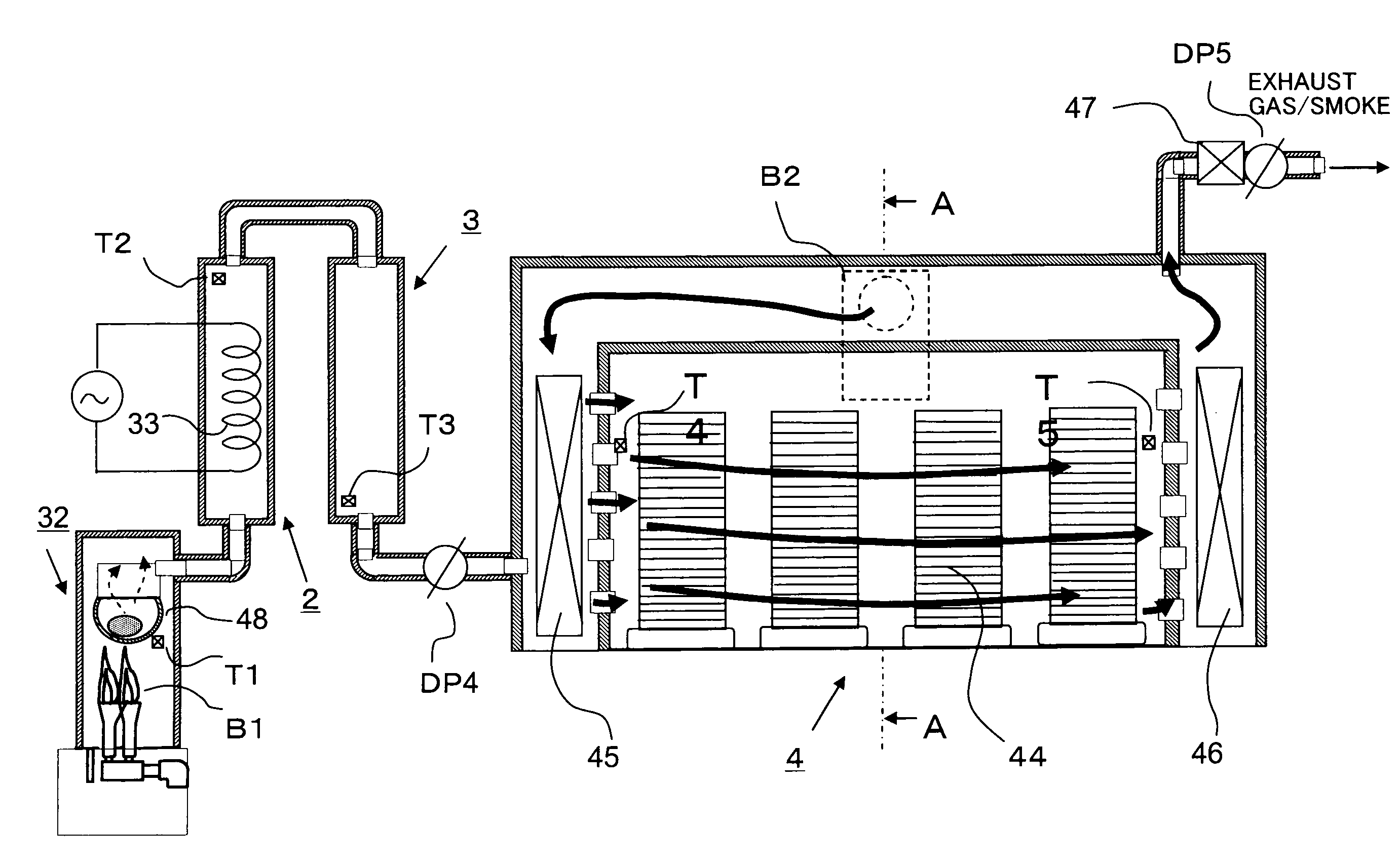Method and device for improving flavor of smoke and process and device for producing smoked food
a technology of flavor improvement and process, applied in the direction of food preparation, meat/fish preservation by drying, milk treatment, etc., can solve the problems of inability to meet the time-consuming and labor-intensive nature of smoking, and the inability to achieve the optimal conditions of drying and smoking
- Summary
- Abstract
- Description
- Claims
- Application Information
AI Technical Summary
Benefits of technology
Problems solved by technology
Method used
Image
Examples
example 1
Effect of Secondary Heating on Quality of Smoke and Amount of Benzopyrene
[0093]Oak chips were heated at 400° C., and generated smoke was cooled and collected over 20 minutes, whereby 12.0 g of a smoke liquid was obtained. Further, smoke generated in the same manner was subjected to secondary heating at 600° C. using a secondary heating unit 14, followed by cooling using a cooling tube 18 and then collecting, whereby 13.2 g of a smoke liquid was obtained.
[0094]The results of evaluating the top-note and the results of measuring the amount of benzopyrene are shown in Table 1.
TABLE 1With or without secondary heatingWithout secondaryWith secondary heatingheating(set at 600° C.)Quality of top-noteWith a sweetWith a somewhatsmoke flavorstimulatingsmoke flavorImprovement effectControlYesAmount ofNot higher thanNot higher than detectionbenzopyrenedetection limitlimit (not higher than(not higher than0.05 ppb)0.05 ppb)
[0095]From these results, it was found that the flavor of smoke can be modif...
example 2
Effect of Temperature of Secondary Heating
[0096]In this Example, in the same manner as in the previous Example, oak chips were heated at 400° C., and generated smoke was subjected to secondary heating at 200° C. to 700° C. using a secondary heating unit 14, followed by cooling using a cooling tube 18 and then collecting, whereby a smoke liquid was obtained. The results of evaluating the top-note are shown in Table 2.
TABLE 2WithoutsecondaryheatingWith secondary heating (° C.)Temperature of−200300400500600700secondary heatingIntensity of sweet++++++++++++++++flavorIntensity of−−+++++++++stimulating flavorIntensity of++++++++++++++++overall flavorImprovementNoYesYesYesYesYeseffect−: Weak+: Somewhat strong++: Strong+++: Very strong
[0097]In the case where the temperature of the secondary heating was 200° C., almost no improvement effect was observed. However, as the temperature of the secondary heating increased, a sweet flavor decreased and a stimulating flavor increased.
example 3
Changes of the Smoke Components
[0098]GC-MS analysis was carried out for the smoke liquids obtained under the respective conditions of “without secondary heating” and “temperature of secondary heating at 600° C.” in Example 2, and the amount of phenols which are typical components of smoke flavor was measured.
Analytical Instrument.
[0099]GC-MS: GC-MATE (BU-20) JEOL Co., Ltd.
[0100]Autosampler (pretreatment and injection device): COMBIPAL, GL Science Co., Ltd.
Pretreatment for Analysis>
[0101]The smoke liquid was diluted to 100-fold with water. A 10 ml portion thereof was placed in a 40 ml vial with a septum cap. While heating the vial at 60° C., the SPME fiber (DVB / PDMS) was exposed to the headspace for 30 minutes, whereby the component was adsorbed thereon.
GC-MS Conditions.
[0102]Column: HP-5MS (0.25 mm×30 M, ID=0.25 μm)
[0103]Injection conditions: temperature: 220° C. mode: splitless, pressure: 1.2 kg / m3·f
[0104]Oven conditions: after the temperature was maintained at 50° C. for 2 minutes...
PUM
 Login to View More
Login to View More Abstract
Description
Claims
Application Information
 Login to View More
Login to View More - R&D
- Intellectual Property
- Life Sciences
- Materials
- Tech Scout
- Unparalleled Data Quality
- Higher Quality Content
- 60% Fewer Hallucinations
Browse by: Latest US Patents, China's latest patents, Technical Efficacy Thesaurus, Application Domain, Technology Topic, Popular Technical Reports.
© 2025 PatSnap. All rights reserved.Legal|Privacy policy|Modern Slavery Act Transparency Statement|Sitemap|About US| Contact US: help@patsnap.com



